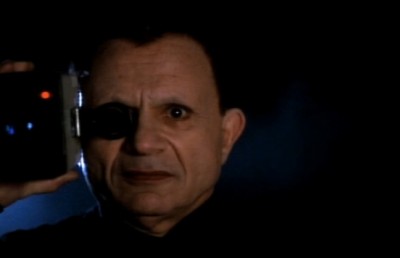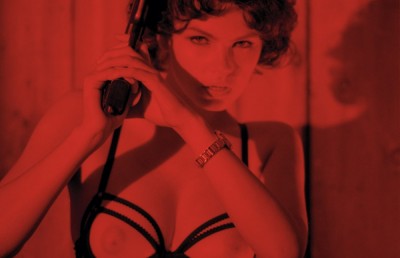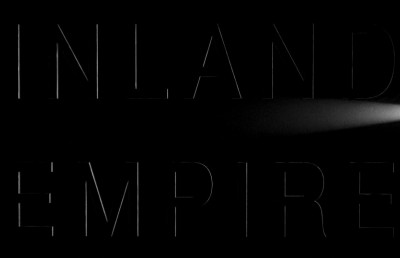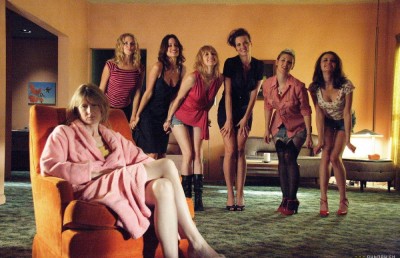Rhetoric of Excess: Hyperbolical Irony as Transcendence in Blue Velvet
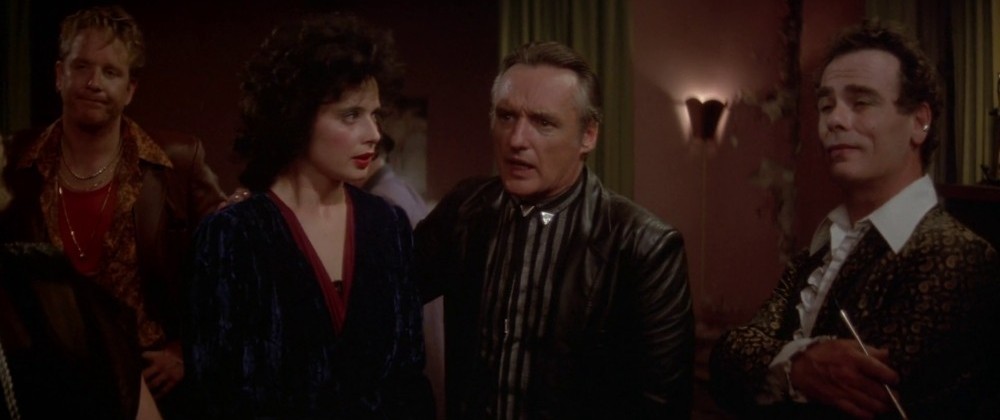
The severely divided reaction to David Lynch’s cult classic Blue Velvet (1986) seems appropriate when considering the film on its own. While lauded by some and despised by others, the film remains contentious partly in the way it oscillates between obscenity and light heartedness, making a precise understanding of its content difficult if not impossible. Components within all his films, such as character identity, genre, revelation, and even stylistic rudiments, are often placed at odds with one another, and heterogeneous items are hurled together to create unsettling and ineffable results. Abhorring circumstances are underlined with a confounding gaiety inasmuch as jovial scenes are painted with a disturbing ghastliness. His films are like freak shows: enrapturing in their monstrosity, unnerving in their familiar alienness. The tension of contrasting elements is present even in the formalistic composition of Blue Velvet which fuses classical Hollywood sensibility to abstract art ideologies. This murky discourse forms the substance of Lynch’s aesthetics, and resonates vibrantly in his grotesque coming-of-age story. Blue Velvet is constructed based on varying degrees of gratuitous imagery, both pleasant and perverse, and this interplay of multiple hyperbolic polarities contributes to the ironic discourse intrinsic to Lynch’s aesthetics.
Duality features predominantly in Blue Velvet, extending from its central theme of “light and varying degrees of darkness” (Lynch 139) into the minutiae of characterization and cinematography. The rural world of Lumberton is divided between the ideal suburbia and its seedy underbelly and the figures which populate either realm. But in the same manner that the whole of Lumberton can not be summarized as neither purely idyllic nor sinister, its residents are subject to a similar dissolution of identity. The superposition of identity appears most pronouncedly when Jeffrey is stowed away in Dorothy’s closet and is forced to observe the distorted courtship ritual between her and her keeper, Frank Booth (42:05 – 50:26). Berry perceives this scene as a relay between alternates, not only between the innocent intrepid Jeffrey and Frank, whom she sees as his doppelganger, but also within Dorothy herself who plays two contradictory roles: one of the child to Frank’s “Daddy,” and then conversely his “Mommy” (83). In the sequence Jeffrey and Frank are placed in antithetical positions. When Jeffrey is first discovered in the closet he is held captive at knife point, implicitly threatened with castration, and commanded by Dorothy not to look at her. When Frank enters the scene her behaviour is somewhat explained. She is quoting Frank eerily, in both words and actions. Like Jeffrey, she is forced to play out a distorted sexual act with Frank out of fear; Frank’s scissors fly dangerously close to her genitals, and he frequently commands her to not look at him. Unlike Frank, however, when she has Jeffrey in her control she assumes a submissive position, kneeling on the floor beneath the standing youth who towers over her. Here the interchange of polar identities blurs into a convoluted web. Dorothy is consecutively the objectified victim, then the oppressive patriarch, then the submissive infant, and then the Oedipal matriarch. Each individual identity is countered with its counterpart, but it is impossible to state quite clearly to which avatar Dorothy ultimate belongs.
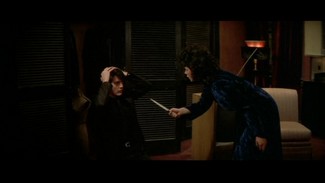
This dualism extends even beyond this scene to the contrasting archetypes represented within Sandy, the all-American virgin, and Dorothy, the dark and troubled femme fatale. The notion that Sandy is virginal in distinction to Dorothy is disrupted by Eric G. Wilson, who deconstructs the concept of the virgin, or parthenos, to its Greek origin. He challenges the contemporary notion of virginal purity as embracing only one definition of the parthenos, that the virgin abstains from sex to preserve her purity, and identifies a second idea of virginity “through having sexual intercourse with many partners” (Wilson 56). Though both definitions seem at odds with one another, they unite on a common ground. The first belongs to no one because they haven’t copulated with anyone, and the second is free because she is unclaimed by a single man; both are liberated from material ownership. In this sense the two characters are both virginal and share that common ground, yet they express their chastity through completely incompatible means. The abstinent virgin is not virginal insofar as she is not promiscuous and the wanton virgin is not defined extensively through the ways in which she is not her counterpart.
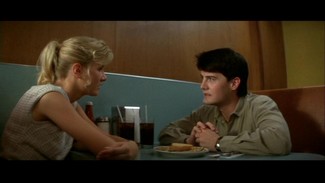
Opposite intensions both negate one another to form a greater, more complex whole known as the virgin. Indeed, as far apart as Sandy and Dorothy are, they both share traits native to the others universe which do not manifest in the other. For instance, Sandy is “drawn to the gloom as much as brightness” (Wilson 66) and ambiguously spurs Jeffrey’s investigation into the world of darkness. Jeffrey acknowledges this himself when he first asks her about the ear, to which she replies, “Didn’t my father tell you not to talk about it?”, and he counters by reminding her that she first brought it up (13:10 – 13:20, DVD time code). Indeed, the manner in which she replies evinces her own curiosity. She is already aware that Jeffrey shouldn’t be speaking of the crime, yet does not attempt to dissuade him, but merely to remind him of the risk associated with it. She slyly coaxes Jeffrey into his descent to the gutters of picturesque Lumberton. Conversely, while Dorothy is the dangerous seductress, she is only this in spite of herself. It is against her will that she is being manipulated and defiled, and when she encounters Jeffrey she asks him to help her, to bring her out from the darkness and back into the light (50: 30 – 51:25, DVD time code). Sandy instigates the translation from light to dark using innocent, juvenile means, and Dorothy beckons Jeffrey’s help through violent and sexual means.
These intermingled dualities are presented characteristically in Lynch’s films, both thematically (most prominently in Blue Velvet) as well as on a formal basis. When Lynch attributes the gradients of light and darkness as the fundamental subject of Blue Velvet, one has to scratch their heads and wonder how that is any different than most films which engage in a dialectic between good and evil. These concepts are present, if not blatant, in almost all films which concern themselves with characters in conflict, yet we can understand them far more clearly than the hopelessly vague narratives of Lynch. The principle difference is in the way that Lynch fuses the two contraries into one ineffable impression. In a more conventional film, good and evil play against each other in order to strengthen the distinction between the two, thereby solidifying the audience’s rational grasp of either concept. The protagonist is good because he doesn’t behave according to the same system as the antagonist. But this division decomposes in “Lynchland,” destroyed yet maintained, and sublate into an amorphous and indeterminable aesthetic. This sublation is seen by Wilson as a religious cinema for Lynch, and forms an ironic dialectic of negation which traverses all dichotomies to essentially reveal true reality: “In negating clarity, in annihilating a sense of purpose, one discovers a deep lucidity, a connection to an ultimate end” (Wilson 111).
This ironic discourse emanates from the nature of the cinematic medium itself, which Wilson sees in Lynch’s religious cinema as “opaque and translucent, hallucination and reality, form and emptiness” (3). In the most fundamental manner Lynch wields two contrasting theories on film, formalism and realism, in order to betray one another. Formalism, which stresses the internal consciousness of the artist, appears in brief montages sporadically in Blue Velvet, where intermittent shots of Jeffrey’s hospitalized father distorted and stretched, Frank screaming in slow motion, a whimpering flame on a candle, and then Dorothy’s plea to be hit are placed in succession (52:30 – 52:50 DVD time code). These sequences do not follow any standard montage theory, nor do they communicate in the plot as much as they reiterate it, albeit in a warped and surreal manner. Realism is achieved in long takes featuring composition in depth, the primary tenets of Bazinian realism, such as Jeffrey and Sandy’s adolescent stroll through the neighbourhood after seeing Dorothy’s apartment for the first time (15:06 – 15:40, DVD time code).
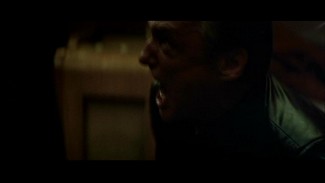
Connecting the idea of film as religion to these theories, Wilson observes that “Spiritual realism emphasizes matter over mind. Spiritual formalism does the opposite, valuing mental action over material stasis” (9). Accordingly, the scenes of abstract montage would seem to depict mental processes within the film, and the long takes would stress the bare reality of the scene. But these formal approaches, like theme and character identity, disintegrate when Lynch fuses the two together. For instance, when Frank first meets Jeffrey and takes him with Dorothy and his gang into the lion’s den to meet Ben, there is an abundance of long takes and compositions using several dimensions of depth, yet the scene is puzzlingly surreal (1:13:10 – 1:21:10 DVD time code). The mise-en-scène is gratuitous: fat women in uniforms of pearls and stockings, fleshy pink walls splattered with light from too many lamps for such a small corner. Mostly, it is in the tone of the scene that Lynch disrupts a simple viewing experience. The spectator is already aware of the danger that Jeffrey is in, and how violent Frank can be, yet there is an odd playfulness to the scene. This darkness, the evil that has tantalized Jeffrey thus far, is somehow a specifically ordered chaos for the gang to revel in.
Ben’s place pic
Most bizarre is the brief “performance” by Ben of Roy Orbison’s “In Dreams,” a song which returns later when Frank brutalizes and deserts Jeffrey. In the context of the scene, the last thing one would expect to encounter here is an impromptu recital, yet this is exactly what happens. The curtains on either side of the arch in which Ben lip-synchs suggest a proscenium arch, which prompts a connection with Lynch’s later film, Mulholland Drive (2001). Mulholland Drive ends in the Club Silencio, which for Wilson “emphasizes the artificial quality of the movie, the fact that it is a construct occurring in a theater. But … this theatre is reality itself, the third realm generating and destroying both illusion and fact” (23). Though less pronounced in Blue Velvet, the theatricality of the scene robs it of its realism, yet the techniques used to capture it suggest on a formal level that it is indeed real, and then even more it is only a film, a shadow play. Somewhere within all of these negating ingredients there is a stirring impression created, one of peace and turmoil intertwined, and lends us perspective into Jeffrey’s experience.
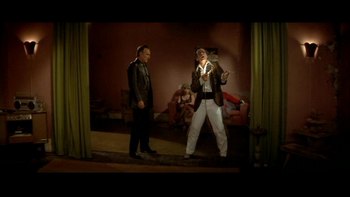
Lynch accentuates the irony of these negating elements by pushing them to extremes, furthering their incompatibility and their absurd relationships within the context. Probably the most excessive and offensive example of this is the graphic nudity prevalent in Blue Velvet. Feminine sexuality is also an intrinsic factor in the film noirs which influenced Blue Velvet, particularly through the untrustworthy femme fatale who brings about the downfall of the man who is foolishly seduced and manipulated by her. In film noir the woman presented an enigma (Doane 102), one which must be understood. This echoes Blue Velvet, wherein Jeffrey is enticed by the mystery of the femme fatale, Dorothy. But Doane sees the film noir femme fatale as engaged in a constant striptease, in which she never becomes actually nude. In fact it is the act of undressing, of removing layers with innuendo of nudity, which gives her a seductive hue. But it is necessary that this act never finds completion, that the man is never presented with his desire because “the completely nude body, which structures the way in which the woman is looked at, is necessarily an anticlimax” (Doane 106). The culmination of the striptease is best articulated by Barthes “to signify, through the shedding of an incongruous and artificial clothing, nakedness as a natural vesture of woman, which amounts in the end to regaining a perfectly chaste state of the flesh” (Doane 106). Barthes’ use of the word chaste is ironic here, in that it would seem contradictory to the end result of a striptease, but it makes sense if Wilson’s bipartisan parthenos is reconsidered. For Wilson, the impetus behind virginal worship is “to know the virgin intimately, to gaze on her or to embrace her in hopes of achieving full acquaintance” (57) and these two ideas converge during the scene where Jeffrey watches Dorothy undress from the closet. (34:50 – 37:75, DVD time code) Dorothy strips, but doesn’t do so in a sexually contrived way. Unknowingly, she is indeed still performing, shedding “incongruous and artificial clothing” as she pulls off her dress and wig, ornaments which she later puts back on for Frank.
The anticlimactic nature of final nudity is observed also by Berry, who proposes that “when we see her naked –and that is exactly how Lynch wants us to see her, naked rather than nude– she is anything but erotic” (86). This nudity is reserved for a later scene where Dorothy emerges from the darkness naked and withered, seeking Jeffrey’s help in her final desperation (1:40:54 – 1:42:05, DVD time code). Her nakedness is excessive in this scene, and Isabella Rossellini acknowledges herself that this scene is one of the more offensive ones in the film (“Hey Neighbor” 8:29 – 9:00, DVD Extras Feature). She recounts a story told to her by Lynch himself that when he and his brother were younger they found a naked woman walking down the street and reacted in fear, that there was nothing sexual about it. Here the paradoxical relation of dualities finds its climax, encased in a single image. The nude form of Dorothy is without an identity: at first Sandy’s boyfriend reacts in humour, but very quickly they understand the severity of the situation. Berry’s distinction between nudity and nakedness is instrumental in comprehending this, that an unclothed body is not inherently sexual. Like Sandy’s boyfriend who first laughs and then retreats, the audience is rocked in several directions by the scene. At first sight of the nude body the spectator is titillated, but we soon cower from the horrific release. There is no logic to the image, no point to be made, only the shear impact of the audience’s conflicting reactions reverberating through them.
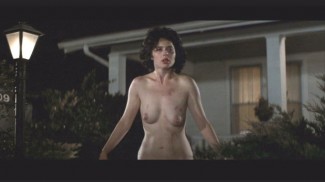
Blue Velvet is a difficult film to grasp because it makes no claims without relating them to its opposite through irony. Attempting to understand the film as a single entity, or as a series of polar opposites produces a incomplete viewing. To focus on any single element, even in relation to its antithesis, is to try to penetrate the film through rational means, but as Lynch says best, “Words get in the way. Rational thinking gets in the way. It can really stop you cold” (Lynch 140). The substance of his films is the sensation or impression which resonates between any two contraries, and Lynch elicits this tertiary idea by juxtaposing scenes of hyperbolic imagery, the violence bound in sex, the evil encased in good, the joviality present in danger. Together these elements converge into a surreal experience which distinguishes Blue Velvet, and Lynch’s aesthetics in general, from any conventional mode of interpretation.
Bibliography
Berry, Betsy. “Forever, in My Dreams: Generic Conventions and The Subversive Imagination in Blue Velvet,” Literature/Film Quarterly vol. 16, no. 2 (1988): 82-90.
Doane, Mary Ann. Femmes Fatales: Feminism, Film Theory, Psychoanalysis. New York: Routledge, 1991.
“Hey Neighbor”. Blue Velvet. Dir. David Lynch. 1986. DVD. MGM Home Entertainment, 2004.
Lynch, David. “She Wasn’t Fooling Anyone, She Was Hurt and She Was Hurt Bad: Music and Blue Velvet.” Lynch on Lynch, Boston: Faber and Faber, p. 1997, 125-154.
Wilson, Eric G. The Strange World of David Lynch: Transcendental Irony from Eraserhead to Mulholland Dr. New York: The Continuum International Publishing Group, 2007.


